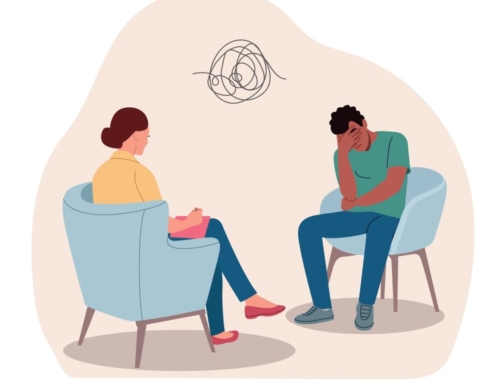Triggers and panic: Learn to relax naturally by speaking your body’s language

Photo by Joshua Woroniecki on Unsplash
Written by Jenna D’Anna
Have you ever found yourself stuck in a thought spiral? You try to think of anything but that thing you don’t want to think about. But your mind keeps wandering right back to that conversation or a recent event. You create narratives in your head and find yourself distracted from wherever you currently are. Being triggered and having panic out of nowhere is awful.
You might even feel like your mind and body are at battle. You’re ready to move on but your body is not on the same page. When you find yourself in these thought spirals, you may feel some tightness in your chest, a flash of heat, your heart racing, or even a wave of sadness.
The good news is that all of those sensations can be incredibly helpful. When we take the time to look somatically, or within the body, at what we’re experiencing, there’s a world of information. Ignoring the body and all the information it is providing might seem convenient in the moment (who’s got time for that?!), but it actually makes things worse in the long run.
In a society that’s moving faster than ever, it’s easy to feel like there’s no room for our heavier emotions and sensations. If you aren’t looking on the bright side or understanding that it could have been worse, you must be doing something wrong. There is little space to be disappointed, angry, sad — the list goes on. You do your best to push whatever you’re feeling down and move forward.
But inevitably, when you have some downtime and your mind begins to settle, what happens? I’ll bet your mind go right back to that situation you’ve been trying to avoid. You might even find that your body is even more revved up than it was before.
We are a cognitive society, meaning we like to believe that we can think our way out of our feelings and problems. No matter how much you push the inconvenient and painful stuff away, though, it will always still be there. The thing is, our bodies don’t always respond to thinking.
In fact, the “thinking” part of the brain, or the prefrontal cortex, shuts down when it experiences fear, traumatic events, and overwhelming amounts of stress. Instead, the “fight, flight, or submit” section of the brain, known as the amygdala, will light up and create emotional, nonverbal reactions and memories.
What this means is that, in high-stress situations, we can’t think our way out of what we are experiencing because these experiences are being perceived and stored directly within the body. The body holds onto these memories and communicates them, not through rational thoughts, but through sensations.
Dr. Peter Levine coined the term “felt senses,” which describes the bodily awareness of the experiences and sensations around us. Felt senses carry messages from your body and will speak to you — when you listen.
When we provide room for nonjudgemental curiosity towards what we are somatically experiencing, our understanding of the body’s language builds. Communicating cognitively, like, “calm down” or “just let it go”, when we are under distress is like trying to take a test in a language you’ve never learned. Say these things to yourself all you want – the body doesn’t and won’t understand.
You’ll be amazed by how your body will start to shift from those heavy emotions to a more neutral space, once you start communicating through the body’s native language. Noticing and identifying your felt senses is like providing comfort to the child that scraped their knee and is now screaming.
So how do you start to speak the language the body can understand? It starts by becoming curious and slowing down.
This is not a small task. Slowing down is an essential step towards breaking the habitual reactivity that typically happens when we begin to feel upset or dysregulated. This is where the cognitive spirals stem from — the body becoming accustomed to responding to emotional triggers in a certain way.
If, instead of falling into our habitual response, we take steps to slow down, notice, not react, and begin to name the felt senses, we retrain our brain to a new kind of response that is based in the here and now. This will begin to calm the alarm bells, amygdala, down and give your problem solving, prefrontal cortex, a chance to re-engage. “Name it to tame it”, psychiatrist Dr. Daniel Siegel likes to say.
The next time you notice yourself falling into a spiral, take one step back and just start to notice your felt senses. You may find that these sensations are most likely familiar to you. When we become familiar with our bodily experience, we learn what makes us tick or what ticks us off.
Our goal is to begin to build ‘parallel processing’ or dual awareness. In other words, the idea is to be able to both feel and observe at the same time. This is what allows us to begin to stand at a slight distance from what is happening emotionally and physically and just notice the sequence of feelings, thoughts and body sensations that follows.
Is this felt in my chest? Does my body feel tense? Where? Have I become fidgety? Have I started to distract myself with my phone?
Questions like these allow our brain to shift from a stress response back to the present moment. This is mindfulness at its core.
Try this with me. Wherever you are as you read this, make yourself as comfortable as possible. Feel the way your body makes contact with the surface that is supporting you. Sense the way your clothes feel. Be curious about those sensations. Are you warm or cold? Is your clothing loose or constricting or maybe fits just right? Is it soft or scratchy? Do you feel the support of whatever you may be sitting on? Is it a hard or soft surface?
Now, gently notice the sensations that bring you comfort. How do you know that you feel comfortable? What physical sensations contribute to the overall feeling of comfort? Enjoy these comforting sensations for a few moments.









